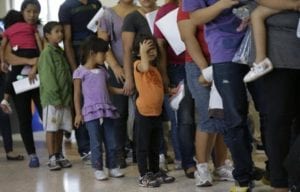What’s the Immigration Law Behind a Policy of Separating Children from Parents at the Border?
This year U.S. immigration laws, processes, and policies have dominated the headlines. We started 2018 with a divisive debate on how or whether to protect the young Dreamers under DACA. Since we’ve seen issue after issue emerges from the press and White House.
Immigration in the Headlines and Under the Radar

Just in the past six months, we’ve discussed overhauling the entire U.S. immigration policy. We noted an uptick in the number of people deported from the U.S., and a drop in the number of people detained at the U.S. border, followed by a steep rise in the number of individuals attempting an illegal border crossing. We heard the Trump Administration announce the end of Temporary Protected Status for Hondurans in the U.S., on top of earlier announcements to end similar protection for people from Haiti, El Salvador, Nicaragua, Sudan, and Nepal.
Less noticeably, a California immigration lawyer has seen changes to student visas, policy shifts towards legal foreign workers, and the end of asylum for victims of domestic violence. All of these policy and legal changes have an impact on how easy or difficult it is to navigate the U.S. immigration system. Currently, it’s complicated and unreliable, and the advice of a California immigration lawyer even more valuable.
What Are We Talking About Today?
Now, the country is fully focused on another issue. The Trump Administration announced that in April and May nearly 2,000 children were separated from their parents at the U.S. border. These migrant families were separated on the basis of the parents’ undocumented status in the U.S.
What laws and policies are behind these headlines and how can they impact other immigrants and migrants in California?
When Did a Policy of Separating Families Begin?

The dilemma of how to deter illegal immigration on the U.S.’s southern border with Mexico is nothing new. Past presidents have faced the same question and developed different policies to try and curtail and contain the issue. However, neither Republicans nor Democrats have relied on the same rhetoric or strict policies as the Trump Administration.
Soon after his inauguration, President Trump’s team announced a possible change to policy and procedure at the U.S. border. The administration wanted to separate parents that illegally crossed the border from their minor children. This wasn’t a novel concept back in 2017, as adults and children have been routinely separated under other administrations when there was fear for the minor’s safety and security. Most often, the policy was employed when border patrol suspected that the adult was a trafficker or abuser.
Trump’s initial decision to broaden this separation policy was dropped after substantial pushback from the public and other politicians. However, the Trump Administration revived the idea as part of the zero-tolerance policy announced in early April 2018. The zero-tolerance approach of the current administration presents several questions and considerations for a California immigration lawyer, but few as dividing and complicated as this separation policy.
What Immigration Laws Provide the Basis for Separating Families?
There are plenty of federal laws that deal with illegal immigration, deportation, immigration hearings, and border security. The U.S. has relied on some of these laws for a very long time, while other policies are relatively new. There is also a substantial amount of court precedent for how to approach families with minor children illegally crossing the border.
Some of these laws directly deal with the question of minor children crossing the border illegally. For example, the Homeland Security Act of 2002 created the Office of Refugee Resettlement (ORR), which is responsible for the care, housing, and safety of unaccompanied minors crossing the border. The ORR has recently become the caretaker of these nearly 2,000 children separated from parents in the past two months.
Yet, none of the laws or prior policies give a California immigration lawyer a clear roadmap to the current separation policy. Rather, the Administration bypassed certain standards and aspects of these policies to craft its stance on separating parents and minor children.
What Will Happen Next?

At this time, it’s hard to determine what will happen next. New legislation could eliminate the policy, but those terms still need to pass in Congress.
The Trump Administration is largely claiming that the border separation policy is a deterrent policy meant to stifle illegal immigration and make the border safer. But many don’t see it that way. Critics, including key Republicans, have called it inhumane, a humanitarian crisis, and morally problematic. Others feel the real purpose is political, with the elimination of this policy becoming a bargaining chip for President Trump’s promised wall or other immigration reform.
What migrants and other immigrants to California should know is that regardless of documentation or how you arrived in the U.S., if your immigration status is in question, now is the time to talk to a California immigration lawyer. You can contact a reliable California lawyer at Greco Neyland by calling 213-295-3500. We are available 24 hours a day to take your call and start working on your case.
What’s the Immigration Law Behind a Policy of Separating Children from Parents at the Border?
This year U.S. immigration laws, processes, and policies have dominated the headlines. We started 2018 with a divisive debate on how or whether to protect the young Dreamers under DACA. Since we’ve seen issue after issue emerges from the press and White House.
Immigration in the Headlines and Under the Radar

Just in the past six months, we’ve discussed overhauling the entire U.S. immigration policy. We noted an uptick in the number of people deported from the U.S., and a drop in the number of people detained at the U.S. border, followed by a steep rise in the number of individuals attempting an illegal border crossing. We heard the Trump Administration announce the end of Temporary Protected Status for Hondurans in the U.S., on top of earlier announcements to end similar protection for people from Haiti, El Salvador, Nicaragua, Sudan, and Nepal.
Less noticeably, a California immigration lawyer has seen changes to student visas, policy shifts towards legal foreign workers, and the end of asylum for victims of domestic violence. All of these policy and legal changes have an impact on how easy or difficult it is to navigate the U.S. immigration system. Currently, it’s complicated and unreliable, and the advice of a California immigration lawyer even more valuable.
What Are We Talking About Today?
Now, the country is fully focused on another issue. The Trump Administration announced that in April and May nearly 2,000 children were separated from their parents at the U.S. border. These migrant families were separated on the basis of the parents’ undocumented status in the U.S.
What laws and policies are behind these headlines and how can they impact other immigrants and migrants in California?
When Did a Policy of Separating Families Begin?

The dilemma of how to deter illegal immigration on the U.S.’s southern border with Mexico is nothing new. Past presidents have faced the same question and developed different policies to try and curtail and contain the issue. However, neither Republicans nor Democrats have relied on the same rhetoric or strict policies as the Trump Administration.
Soon after his inauguration, President Trump’s team announced a possible change to policy and procedure at the U.S. border. The administration wanted to separate parents that illegally crossed the border from their minor children. This wasn’t a novel concept back in 2017, as adults and children have been routinely separated under other administrations when there was fear for the minor’s safety and security. Most often, the policy was employed when border patrol suspected that the adult was a trafficker or abuser.
Trump’s initial decision to broaden this separation policy was dropped after substantial pushback from the public and other politicians. However, the Trump Administration revived the idea as part of the zero-tolerance policy announced in early April 2018. The zero-tolerance approach of the current administration presents several questions and considerations for a California immigration lawyer, but few as dividing and complicated as this separation policy.
What Immigration Laws Provide the Basis for Separating Families?
There are plenty of federal laws that deal with illegal immigration, deportation, immigration hearings, and border security. The U.S. has relied on some of these laws for a very long time, while other policies are relatively new. There is also a substantial amount of court precedent for how to approach families with minor children illegally crossing the border.
Some of these laws directly deal with the question of minor children crossing the border illegally. For example, the Homeland Security Act of 2002 created the Office of Refugee Resettlement (ORR), which is responsible for the care, housing, and safety of unaccompanied minors crossing the border. The ORR has recently become the caretaker of these nearly 2,000 children separated from parents in the past two months.
Yet, none of the laws or prior policies give a California immigration lawyer a clear roadmap to the current separation policy. Rather, the Administration bypassed certain standards and aspects of these policies to craft its stance on separating parents and minor children.
What Will Happen Next?

At this time, it’s hard to determine what will happen next. New legislation could eliminate the policy, but those terms still need to pass in Congress.
The Trump Administration is largely claiming that the border separation policy is a deterrent policy meant to stifle illegal immigration and make the border safer. But many don’t see it that way. Critics, including key Republicans, have called it inhumane, a humanitarian crisis, and morally problematic. Others feel the real purpose is political, with the elimination of this policy becoming a bargaining chip for President Trump’s promised wall or other immigration reform.
What migrants and other immigrants to California should know is that regardless of documentation or how you arrived in the U.S., if your immigration status is in question, now is the time to talk to a California immigration lawyer. You can contact a reliable California lawyer at Greco Neyland by calling 213-295-3500. We are available 24 hours a day to take your call and start working on your case.
free case evaluation
Results That Matter to You




